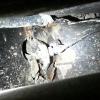This could be a better place than hijacking Stevede's project thread....
The pre-verto clutch uses a diaphragm spring - like a shallow cone of steel that behaves similar to a frisbee of dustbin lid, in that the if you push the centre in far enough it reaches a point where it's on the verge of inverting and popping out the other side. At that point the spring won't be pushing in either direction, so won't be capable of putting any reaction force through the flywheel onto the crank thrusts.
I've mentioned this on Steve's thread, with a link to a good article on Minimania's site. Giving it some more thought, I reckon it's an idea worth developing. The Minimania article suggests setting up the clutch with the diaphragm spring flat when compressed: which would theoretically be that sweet spot. Would that work out in reality though? It's unlikely the stresses on either side of the spring would be exactly equal & opposite. What could be interesting would be to measure the actual effect on the pressure the spring transmits. I'd propose putting together a test rig to press on the clutch in place of the release bearing to measure the load applied:
Initially, to obtain the clamping pressure on the friction plate.
At the point the clutch releases, the minimum load you're likely to put on the thrust bearings.
The minimum value at, or near, the spring going flat, which would be our sweet spot.
We'd then tinker about adjusting the fitting height of the clutch diaphragm to try and get the sweet spot & clutch release to coincide so we can measure the effects and see what scope we have for getting the most holding power out of our clutches while minimising the wear on our crank thrust bearings.
Ideally, we could do with a hydraulic press with a pressure gauge that we can work out how much force is on our test rig - anyone?




 This topic is locked
This topic is locked

















